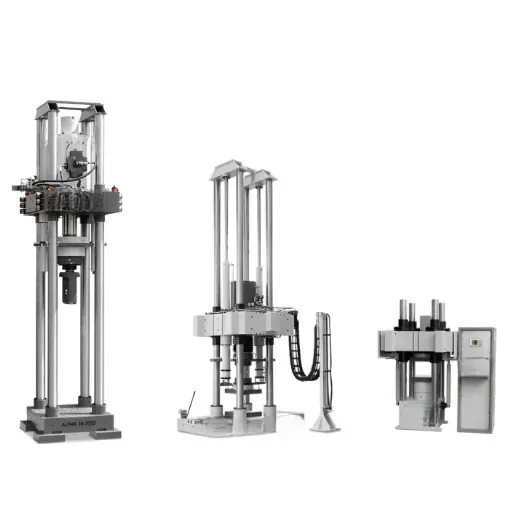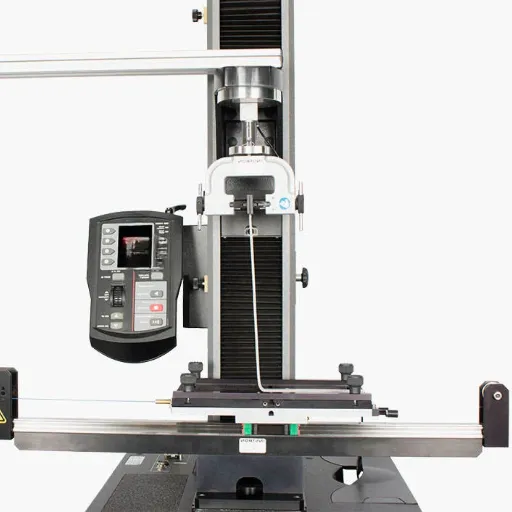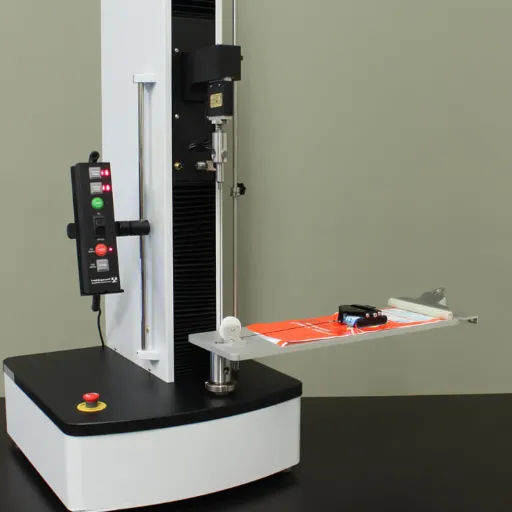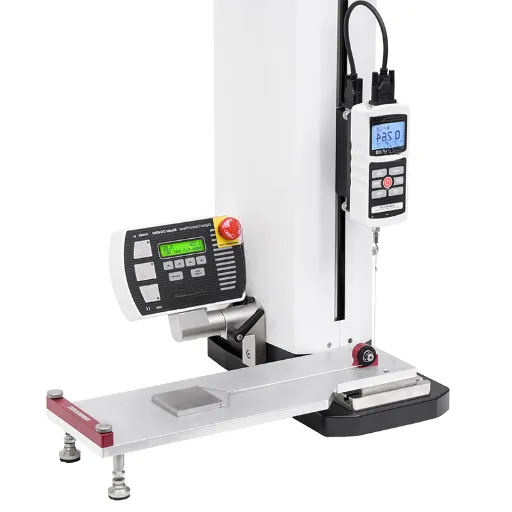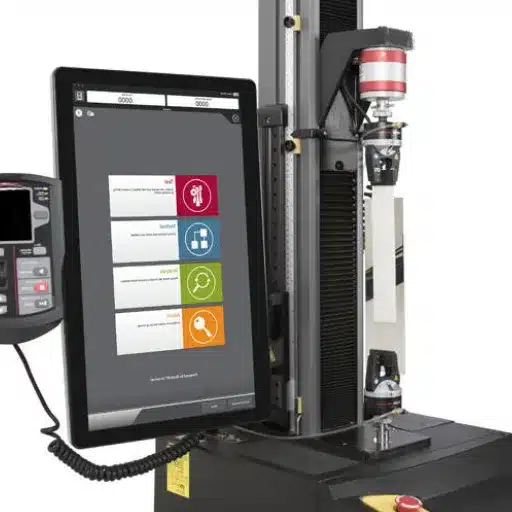Knowledge about strength and durability is very important from construction to manufacturing. The compression test is basically concerned with studying how the materials will perform under pressure and whether they satisfy safety and quality standards. But what do we infer from the term ‘compression test’ and how does it operate? This blog explores the basics principles of compression testing, how a compression testing machine works, and why this testing is important across industries. Whether an engineer, a quality control specialist, or simply interested in learning some basics of material science, this complete guide will enlighten you about one of the most significant testing and analysis processes. Keep reading to understand the contribution of compression tests toward erecting safe, sturdy, and reliable structures and products.
Understanding the Compression Test
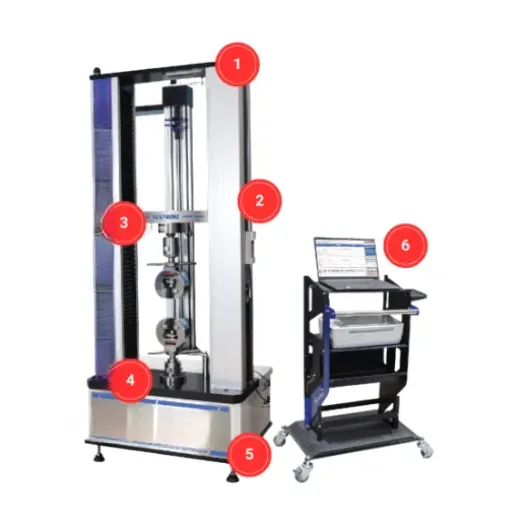
Definition and Purpose of a Compression Test
A compression test records the behavior of a material when put to the test with a compressive load. Controlled force is applied to a sample, and the response is noted-deformation, fracture, or indeed complete failure. Tests for determining the compressive strength, elasticity, and strain allow predicting the possible response of a material under pressure in field application.
A compression test mainly assesses the material’s capacity to bear compressive forces without altering its profile or breaking down. This feature is essential in areas such as construction, manufacturing, and engineering wherein materials do get subjected to intense pressure. For example, a test can ascertain if the material for buildings, concrete, or metal can bear stress from structural loadings to provide a more rigid and safe base.
The data collected from a compression test allow engineers and designers to choose materials for particular purposes, to guarantee product reliability, and to keep safety requirements intact. Naturally, this test serves as a crucial factor in quality control and in the making of a product since it certifies a material can perform as it should in differing environmental and operational conditions.
Overview of Testing Machines Used
Compression testing machines hold a very important place in the test world of materials in so far as they are tested under loads of compression. The machine exerts a controlled pressure on a sample and measures its response to stress to characterize properties like strength, ductility, and deformation. They are hence very useful across industries in testing materials for adherence to specified performance and safety standards.
Most compression testing machines employ a load cell and crosshead mechanism in measuring force and displacement. The machines are generally versatile-they accept different sample sizes and shapes, allowing the testing of a variety of materials, either metal, plastic, composite, or ceramic, in a uniform way. The operation of these machines generally follows some standards laid down by the industry so that they yield reliable and uniform results.
On the other hand, advanced testing machines mostly have digital interfaces and software for data collection and analysis. This fosters in giving the precise report and helping the technician interpret the results efficiently. Whether in research and development or in quality assurance, compression testing machines are instruments of material validation and improvement, thereby providing support for innovation and safety in engineering applications.
Key Applications of Compression Testing
Compression testing finds applications in a wide variety of industries. The construction is perhaps the most important. Here, materials such as concrete, bricks, and cement are evaluated with respect to their ability to resist load-bearing stresses. Testing assures structural integrity as buildings, bridges, and other infrastructures are erected, thus being critical to safety and standards.
Industry Applications:
- Construction: Testing concrete, bricks, and cement for load-bearing capacity
- Manufacturing: Evaluating metals, plastics, and composites for mechanical properties
- Automotive & Aerospace: Ensuring component reliability and performance
- Packaging: Testing cardboard and foam for shipping protection
Another important application imparting the manufacturing sector to test metals, plastics, and composites for their mechanical properties. Knowing how strong and durable compression tests can be of materials ensures the components and products are able to withstand forces during their product lives. This is especially true for the automotive and aerospace sectors where the performance of materials is synonymous with reliability.
Compression testing is also essential for packaging industries. It measures the strength of packaging materials such as cardboard and foam before they are used so that the product remains secure during shipment and storage. In evaluating the compression strength of packing materials, manufacturers can provide the best solution, considering material efficiency and product safety. These various uses underscore the value of compression testing in quality assurance, fostering innovation, and safety across various fields.
Types of Compression Tests
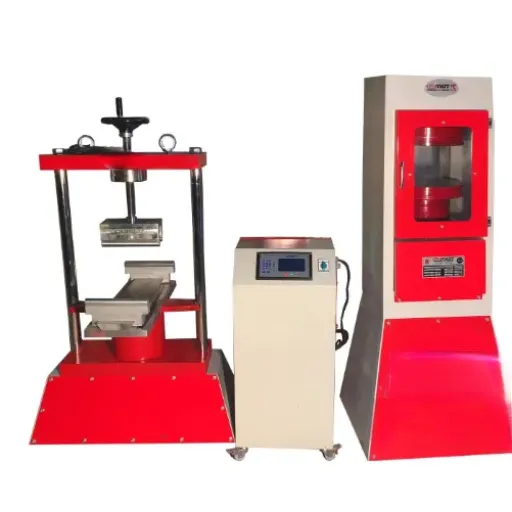
Standard Compression Tests
Standard compression testing is the core method for determining the engineering properties of materials subjected to compression. When a compressive load is applied, the evaluation involves the compressive strength, elasticity, and deformation characteristics of the material. Standardly, it is used in sectors such as construction, packaging, and manufacturing, wherein materials must carry a load without breaking.
The procedure usually involved in the standard compression test requires placing the test specimen usually a cube or a cylinder in the compression testing machine. Force is applied onto the specimen gradually until it either yields or fractures. The information recorded during the test, such as the maximum force applied and the deformation produced, is used to calculate parameters such as compressive strength and modulus of elasticity.
Besides this, standard compression test methods are widely used. For example, construction can test structural elements, concrete and bricks, for safety norms in load-bearing structures. Likewise, tests ascertain whether the boxes and containers in the packaging industry withstand stacking pressure. All these tests are vital for instructing industries to develop and use materials that are efficient and reliable.
Dynamic vs. Static Compression Tests
| Aspect | Static Compression Tests | Dynamic Compression Tests |
|---|---|---|
| Loading Method | Constant or slowly increasing load | Rapid, short-duration loads |
| Purpose | Study material response over time | Model impact, vibrations, fast forces |
| Applications | Construction, steady load situations | Automotive, aerospace, packaging |
| Key Properties | Compressive strength, elastic deformation | Energy absorption, sudden deformation resistance |
Dynamic and static tests in compression differ in their application and methodology, imparting different knowledge about the material behavior depending upon the loading conditions. Static compression tests consist of applying a constant load or a load increasing very slowly with time to study the material response over a large time interval. Properties such as compressive strength, elastic deformation, and permanent deformation are usually studied by static compression tests. Therefore, these tests may be suitable for materials that will have to resist steady or slowly varying loads.
On the flip side, dynamic compression tests subject materials to loads that act rapide and lasting for a very short time interval. These are meant to remodel situations where materials may face impacts, vibrations, or whatever forces of fast velocity. These find out if the material capacity to absorb energy, resist sudden deformation, or lose its integrity under instant massive stress. It is rather a crucial thing for the automotive, aerospace, and packaging industries.
The need for dynamic or static compression tests will depend largely on how the material will be applied and the environmental factors it will find itself in. Static test is suited for situations like construction, where materials know steady forces and predictable ones. Dynamics tests are needed for materials that are hit with unpredictably fast forces so evaluation and reliability are ensured through the adverse conditions. Altogether, then, these tests enable the industries to choose and optimize material for their specific intent.
Compressive Strength Testing
The compressive strength testing determines how much compressive pressure the material can withstand without suffering from failure. Such testing exists as a basic engineering requirement to test the behavior of materials such as concrete, metals, and ceramics with regard to heavy load applications, giving considerations to their use in construction and infrastructure. By increasing compressive force gradually on the specimen until it either breaks or deforms, the test aims to discover the last maximum stress which the material can endure.
A universal testing machine or a compressive strength testing machine is used to perform this test. The machine is designed to apply adequate pressure to the prepared sample. The support determines the size and shape of the sample such that results can be easily compared. The test observations give the ultimate compressive strength and deformation characterizations of the material tested.
One cannot overemphasize the value of these measures when applied to meet the safety, reliability, and sustainability requirements demanded for intended applications. In the realm of construction, engineering, and aerospace, the compressive strength test serves to verify the choice of materials informed by standards and specifications. This sort of testing is vital for the realization of application and service life of structures and products.
Procedure to Perform a Compression Test
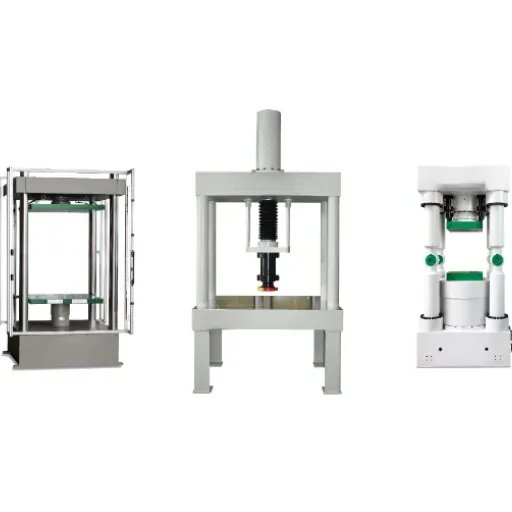
Preparation of the Testing Machine
The testing machine first needs calibration before one can use it for compressive testing. This calibration offers a genuine and satisfactory measuring of compressive forces throughout the measuring process. Check when it was last calibrated and perform a system check if need be, as prescribed by the manufacturer or industry standard.
Examine the components of the testing machine for wear, especially the platens and fixtures; if any slight wear exists, the results of the tests might be affected. The platen surfaces ought to be clean, nicely polished, and free from any debris to ensure uniform load distribution. It is crucial that the hydraulic or mechanical textbooks are in perfect working order and can be aforesaid to be well maintained.
Finally, place the test specimen correctly or properly in between the platens. The sample must be carefully aligned; otherwise, uneven stress distribution will occur, leading to premature failure in the test. Supports or fixtures must be used where appropriate to secure the specimen properly. After all the preparations are complete, the machine is set for the compression test with the assurance of accurate and consistent result.
Sample Preparation for Accurate Results
A properly formed sample yields accurate and reliable results, compressive testing being one of these tests. Thus, sample dimensions and material requirements should be taken into consideration while selecting the specimen for testing. Any structural defects, irregularities, or impurities in the sample need to be removed because they greatly affect the test results. The sample should now be cut or shaped and well-finished with flat surfaces into the specified geometric configuration, so stress distribution is uniform during compression.
Before testing, special attention has to be given to examine the moisture content, surface conditions, and existence of residual stress. When necessary, corrective measures should be taken to meet the conditioning requirements specified in the standards. For example, procedures may call for drying the samples or polishing their surfaces, or even applying a thin coating of lubricant of a specified type and thickness. All these are done to prevent a variety of uncertainties that otherwise might behave in an unpredictable manner under the load conditions of the test.
Finally, keep the testing area clean and neat. Clear away any debris or dust from the machine platen, and ensure the equipment is in correct calibration and working order. Proper little errors occur during specimen alignment, so inspect minutely that the sample is well-centered between the platens because even unbalanced loading might be a legitimate source of result. These things will make sure that your test results are consistent and fair reflections of the real material properties under compression.
Step-by-Step Compression Testing Procedure
Complete Testing Procedure:
-
1
Preparation of Specimen
Commence with the preparation of the test specimen in conformity with standardized dimensions and shapes prescribed for compression testing. The surface of the specimens must be smooth and airy from irregularities that could otherwise interfere with the results. Proper preparation reduces the risk of errors in test results and makes testing results appear more consistent.
-
2
Setting Up the Testing Machine
The compression testing machine should be inspected, ensuring that it has been calibrated correctly and is working. It will then need adjustments in respect of settings of speed of loading and alignment of upper platen in accordance with the testing standard for the material under test. The specimen is then placed and correctly centered between the platens to ensure loading is balanced.
-
3
Carry out the test
Apply compressive force gradually at a loading rate suitable for the test. Observe the performance of the material as the loading progresses with increasing load. Record key parameters such as deformation, stress, and strain until the material yields, fractures, or attains its maximum compressive strength.
-
4
Record and Analyze Results
After the conclusion of the test, results shall be well documented, which include parameters such as max compressive strength, failure mode, and deformation patterns if any; these results shall be compared with industry standards or design specifications to check that the material satisfies the prescribed performance criteria.
-
5
Post-Test Inspection and Cleanup
Examine the specimen after testing for detailed observations about its failure characteristics. Clean the machine from any material remnants so that it will remain ready for other tests. Properly maintaining the equipment will extend its life and keep it accurate for the future.
Critical Factors Affecting Test Results
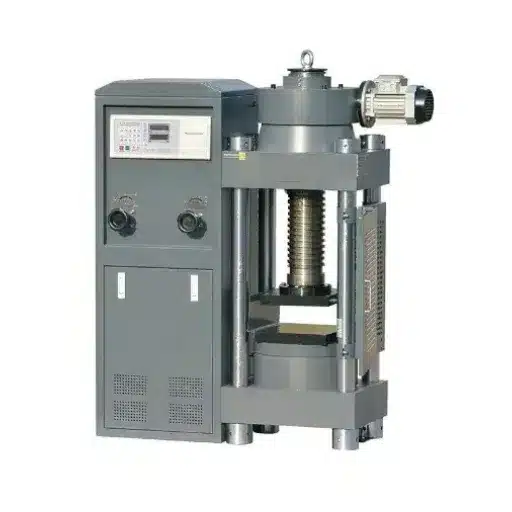
Calibration of the Compression Testing Machine
Calibration is an important step for obtaining accurate and reliable results from the compression testing machine. This step comprises verifying and adjusting the measurements of the machine-against specified standard measurements-to keep the precision in testing. It means that if a machine is regularly calibrated, it would give results in accordance with industry standards with minimum chances of errors in measurement, and errors if any could hamper the validity of the test results.
Thus, the calibrating procedures include checking of the load cell, displacement measurement, and any associated sensors against set parameters to prove they are within tolerances. This is usually done by a professional calibration service or by a technician trained to use enhanced reference equipment traceable to recognized national or international standards, which assures the reading of the machine has a consistency and trustworthiness over time.
If a machine would not be calibrated on a yearly basis, results could be erroneous, thereby resulting in hazards where material serviceability is given utmost importance. In any case, all instances of calibration should be from time to time enough and be witnessed for documentation and could stand as proof of compliance with its quality assurance testing protocol.
Environmental Conditions and Their Impact
Environmental Factors to Monitor:
- Temperature: Can cause material expansion/contraction affecting calibration
- Humidity: May cause corrosion and damage to internal components
- Vibration: Can interfere with sensitive measurement systems
- Air Pressure: Changes can affect equipment performance
Good environmental conditions would have the direct effect on the accuracy and reliability of instruments and machinery. In any performance or measurement of some kind, change in temperature, humidity, vibration, or air pressure becomes a factor. For example, materials may expand or contract depending on temperature extremes, which might upset or interfere with the calibration of very sensitive instruments. High levels of humidity can cause either dust or corrosion; internal parts may get thus damaged and may cease functioning to an extent.
In order to lessen these impacts, equipment must be operated and stored in stable environments. There are specified temperatures and relative humidity ranges to be maintained for proper performance. Protection measures to further keep equipment stable are anti-vibration mounts, desiccant packs to reduce moisture, and pressure control settings. Consistent monitoring of environmental factors is essential to onset detection of deviations hindering the equipment’s performance.
Besides, regular maintenance and recalibration aim at rectifying all possible impacts brought forth by varying environmental conditions. This documentation must be done for quality assurance purposes and for provision of regulatory evidence. Proactively watching and controlling environmental impacts will not only keep equipment reliability intact but will also enhance safety and operational efficiency in the long run.
Importance of Proper Sample Alignment
Proper sample alignment is a margin-of-error consideration to be taken into account in calculating experimental results. One might, in fact, wonder about the very success of any experiment, since misalignments could produce faulty data, lead to maverick analyses, and up for repeat experiments, therefore wasting precious time and resources. Correctly aligning a specimen in such a way will provide repeatable and consistent interactions between the sample and testing equipment, with little to none anomalous behavior making for promising results.
Sample alignment properly also aids in keeping calibration inside specifications. Aligning a sample appropriately renders measurements compatible with standards in the calibration and reduces the potential of calibration drift or error. In any case, thereby, the strength of experimental data is enhanced, and the data’s ability to meet regulatory standards for exact and reproducible results is ensured.
So, giving proper alignment promotes operational efficiency by minimizing errors and fixing downtime associated with reconfigurations or recalibrations. In this way, organizations can increase the reliability of their equipment and also improve the quality of their processes by incorporating standard alignment practices and training their operators. Enhanced productivity, decreased costs, and increased confidence in the results are the outcomes.
Maintenance of Compression Testing Equipment

Routine Checks and Cleaning Procedures
Essential regular maintenance of any compression testing equipment goes hand in hand with ensuring accuracy in results and the longevity of the machinery. Periodically check to see if any of its mechanical parts show signs of wear, damage, or irregularities such as loose bolts, cracking, or misalignment. If any test demarcation standards are set for the equipment, always check for its calibration so that it may carry out exact tests.
Cleaning helps give the machine that little bit of efficiency while making sure test samples remain uncontaminated. Scrape down all surfaces, especially those that had finished in contact with test substances, with suitable cleaning agents to eliminate any detritus or unwanted residues after each usage. Never use materials that act as abrasives, as they may lead to eventual damage to any sensitive components. Thorough cleaning also helps reduce the risk of contamination by foreign particles in other subsequent tests.
Finally, lubrication of moving parts is to facilitate smooth operation of the equipment and to prevent premature wear of the components. Lubricants that are suitable for the particular parts of the machinery should be used, and they must be properly applied as over-lubrication will cause harm. Maintaining a log of all maintenance work, including inspection, cleaning, and lubrication, keeps track of the machine condition for some time, thus ensuring a proactive stance in preserving performance.
Proper Storage Practices
Proper storage of equipment is one of the methods of increasing lifetime and preserving functionality. The machinery should be stored under clean and dry conditions, as moisture can bring about rust and the other forms of corrosion. Dust or any other fine particles as well as extreme temperature conditions should be kept away from the area of storage, as such conditions would hasten the wear and tear of the equipment.
Yet another storage aspect relates to correct positioning. Equipment must be fixed in such a way that undue movements or tilting do not cause damages. Covering with a protective sheet or tarp can ensure that dirt, grime, and other environmental factors don’t reach the machinery. If possible, keep the equipment off the floor, such as on pallets, to prevent possible water damage.
If there is pre-installation storage, then it is necessary to inspect it regularly, as any change inside storage brings with it some sign of dirt or damage due to wear. Furthermore, it is imperative to fit the storage and machine with clean grease seals and lubricants. Structures need periodic inspection even during long storage in order to maintain proper maintenance. Some care such as these, in this way, greatly enhances the life and reliability of the equipment.
Extending the Life of Testing Machines
For the prolongation of life of testing machines, regular maintenance and thorough servicing are essential. Adequate cleaning after work prevents the accumulation of dust and dirt that might affect the normal functioning of the instrument. The lubrication of moving components is equally important as it reduces wear and provides smooth operation. Ensure that you use all cleaning agents and lubricants as recommended for this specific equipment so as to not cause damage to it.
Equally important is the periodic calibration for keeping the machine working life as well as accuracy intact. Calibration verifies that the machine works within the required parameters and consequentially produces reliable results. This should be carried out in line with the manufacturer’s recommendations or in accordance with accepted professional standards to maintain maximum performance. It may also be construed that regular inspection while in use or in storage will bring about the early detection of any possible defects so that repairs can be implemented prior to any further escalation of a problem.
Lastly, for proper maintenance, handling, and storage, the testing machines are protected from undue stresses. Maximize the prescribed limits during normal use of the machine, do not overload it, and do not run it within continual operation for longer intervals without resting. Once used, store the apparatus in a clean, dry, and stable environment to prevent it from being exposed to elements that induce rusting or deterioration. This way, testing machines will consistently offer test results with operational efficiency for many years to come.
Frequently Asked Questions (FAQ)
Q: What is a compression testing machine procedure?
A: A compression testing machine is used in various procedures to test for the compressive strength of various materials such as concrete and metals. The procedure usually includes designing the test specimen, setting up the machine, loading it in compression, and recording the results to see the performance of the material when placed under stress.
Q: How is a compression test performed?
A: The test specimen is placed on the compression platen within the testing machine. The load cell measures the compressive force exerted by the testing machine at a certain test speed until the specimen fails. The results of the test are useful in determining the compressive strength and yield point of the material.
Q: For what materials does one perform compression testing?
A: Any material such as concrete, metal, plastic, or ceramic can be subjected to compressive testing. Materials such as concrete are tested for compressive strength, which is an important property for construction work.
Q: What are the common specifications for compressive strength testing?
A: The common specifications of compressive strength testing indicate the parametric characteristics of the testing as prescribed by ASTM, ISO, and other such bodies relevant to the nature of the test. These specifications ensure an established protocol and test setups in order to obtain reliable and accurate test results.
Q: Why is compression testing important in construction?
A: In construction, compression testing is quite important because it gives insights into the strength and durability of materials used in the framework, in design, and in-service life while constructing concrete beams. This testing enables the producers and engineers to make sure that the material, in the end, meets all specification criteria in terms of safety and performance.
Q: What may be the role of a universal testing machine during compression tests?
A: The universal testing machine is made for carrying out a variety of mechanical tests, both tensile and compression. In compression testing, the force applied to the test specimen is measured, and the data on the compressive strength of the specimen and deformation characteristics are accurately obtained.
Q: Does speed of membrane affect the compression test results?
A: The test speed is a very important factor in the compression testing results. A higher test speed may create a deformation response and failure mode differing from those at a lower speed test. Hence, one must follow the test speed specified for different tests to have consistent results.
Q: What test fixtures will be used for compression testing?
A: The compression testing machine makes use of a sort of test fixture during each test. The test fixture has to hold the test specimen firmly during the operation. Also, it has to ensure that the load is applied evenly so that the response of the specimen could be measured accurately.
Q: Can compression testing be done on brittle or ductile materials?
A: Yes, compression testing can be done on brittle materials like concrete and ductile materials such as some types of metals. The testing is done to determine compressive strength and performance of materials under different loading conditions.
Q: How do they analyze the test results in compression testing?
A: Compression test results are analyzed by determining the maximum load that the test specimen could sustain before failure, which is then used to calculate the compressive strength of the material. This provides the required information regarding the suitability and performance of materials under specific test conditions.
References
- 9 Steps on How To Do a Compression Test – Xometry
This guide outlines the step-by-step process for conducting a compression test, from material selection to evaluating results. - How to Operate a Compression Testing Machine and Its Work – Heicoin
Provides detailed instructions on setting up and operating a compression testing machine. - What is Compression Testing? – Instron
Explains the basics of compression testing, including the procedure and its applications.

